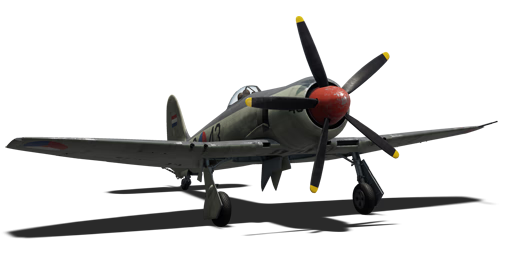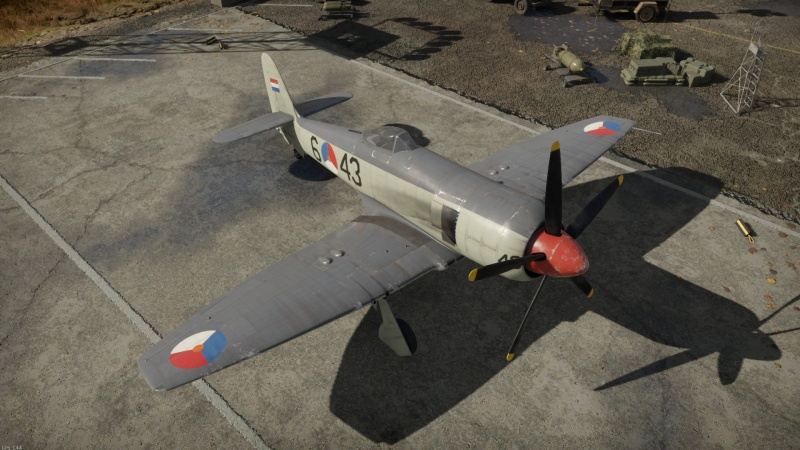Sea Fury FB 51 (France)
Contents
Description
The ◘Sea Fury FB 51 is a rank IV French fighter with a battle rating of 5.7 (AB/RB/SB). It was introduced in Update "Dance of Dragons".
General info
Flight performance
Describe how the aircraft behaves in the air. Speed, manoeuvrability, acceleration and allowable loads - these are the most important characteristics of the vehicle.
| Characteristics | Max speed (km/h at _,___ m) |
Max altitude (metres) |
Turn time (seconds) |
Rate of climb (metres/second) |
Take-off run (metres) | |||
|---|---|---|---|---|---|---|---|---|
| AB | RB | AB | RB | AB | RB | |||
| Stock | ___ | ___ | 10900 | __._ | __._ | __._ | __._ | ___ |
| Upgraded | ___ | ___ | __._ | __._ | __._ | __._ | ||
Details
| Features | ||||
|---|---|---|---|---|
| Combat flaps | Take-off flaps | Landing flaps | Air brakes | Arrestor gear |
| _ | _ | _ | _ | _ |
| Limits | ||||||
|---|---|---|---|---|---|---|
| Wings (km/h) | Gear (km/h) | Flaps (km/h) | Max Static G | |||
| Combat | Take-off | Landing | + | - | ||
| 0 | 360 | ___ | ___ | ___ | ~__ | ~__ |
| Optimal velocities (km/h) | |||
|---|---|---|---|
| Ailerons | Rudder | Elevators | Radiator |
| < ___ | < ___ | < ___ | > ___ |
Survivability and armour
Examine the survivability of the aircraft. Note how vulnerable the structure is and how secure the pilot is, whether the fuel tanks are armoured, etc. Describe the armour, if there is any, and also mention the vulnerability of other critical aircraft systems.
Modifications and economy
Armaments
Offensive armament
The Sea Fury FB 51 (France) is armed with:
- 4 x 20 mm Hispano Mk.V cannons, wing-mounted (137 rpg outer + 153 rpg inner = 580 total)
Suspended armament
Describe the aircraft's suspended armament: additional cannons under the wings, bombs, rockets and torpedoes. This section is especially important for bombers and attackers. If there is no suspended weaponry remove this subsection.
| Default weapon presets | |
|---|---|
| |
Usage in battles
Describe the tactics of playing in the aircraft, the features of using aircraft in a team and advice on tactics. Refrain from creating a "guide" - do not impose a single point of view, but instead, give the reader food for thought. Examine the most dangerous enemies and give recommendations on fighting them. If necessary, note the specifics of the game in different modes (AB, RB, SB).
Pros and cons
Summarise and briefly evaluate the vehicle in terms of its characteristics and combat effectiveness. Mark its pros and cons in the bulleted list. Try not to use more than 6 points for each of the characteristics. Avoid using categorical definitions such as "bad", "good" and the like - use substitutions with softer forms such as "inadequate" and "effective".
Pros:
Cons:
History
Following the end of World War II, the Royal Netherlands Navy established plans to rebuild its fleet. Having drawn lessons from the conflict, the establishment of a naval air service with an aircraft carrier of its own was high on the list of priorities, and pending the acquisition of a large fleet carrier, a smaller escort carrier (HMS Nairana, baptised Hr.Ms. Karel Doorman) was borrowed from the Royal Navy, while Fairey Firefly Mk.I fighter-bombers were acquired to serve aboard the ship.
With the acquisition of a Colossus-Class aircraft carrier in mind, the Royal Netherlands Navy preferred a more modern naval fighter, and following evaluation of both the Hawker Sea Fury and Supermarine Seafang, in October of 1946 an order was placed for 10 Hawker Sea Fury F.Mk.50s, an export version of the F.Mk.10. These aircraft were delivered to the Netherlands in April and May of 1948. The lack of pilots that were carrier-qualified to operate the type meant that these Sea Furies were originally assigned to a shore-based conversion unit; it would not be until 1950 when enough pilots had been qualified to finally operate the type from the Royal Netherlands Navy newer Colossus-Class carrier (ex-HMS Venerable, taking over the name of Hr.Ms. Karel Doorman from the HMS Nairana that was returned to the Royal Navy).
Meanwhile, a dedicated fighter-bomber variant of the Sea Fury, the FB.Mk.11, had entered service with the Royal Navy, and the Royal Netherlands Navy soon placed an order for this as well, with 12 FB.Mk.60s being delivered between May and July of 1950; in 1951 the 8 surviving FB.50s were sent back to Hawker for conversion to FB.60 status. In 1951, an additional order of 25 aircraft was placed, but unlike the earlier F.50s/FB.60s that had been built by Hawker, these aircraft, the FB.Mk.51 variant, would be built under license by Fokker at Schiphol. These aircraft were built at Fokker alongside Meteor F.8s destined for the Royal Netherlands Air Force, with the first finished aircraft being delivered to the Dutch Navy in July of 1951, and deliveries concluding in February of 1952.
In Dutch service, these aircraft were assigned to VSQ 3, a conversion unit which was based at the Valkenburg Naval Air Base near Leiden; and VSQ 860, an operational unit based on the Hr.Ms. Karel Doorman; between 1953 and 1954, the type also saw service with the Dutch Navy's display team, the "Aerobats".
In August of 1955, the Hr.Ms. Karel Doorman was taken out of service pending its conversion to a jet-capable, angled-deck aircraft carrier, with its Sea Furies being transferred to Valkenburg. One year later, in 1956, the decision was taken to replace the Sea Furies by more modern Hawker Sea Hawks. In April of 1957, VSQ 860 was disbanded and its last Sea Furies were withdrawn from service; in July of 1957 VSQ 860 would be reformed with the arrival of the first Sea Hawks.
Out of 47 Sea Furies delivered to the Royal Netherlands Navy, some 17 aircraft were written off in various accidents; most of the surviving aircraft were scrapped following the type's retirement in 1957, with only a handful being retained for museum and training purposes. Of these, Fokker-built FB.51 6-43 was given as an instructional airframe to the Technical University of Delft in 1959, where it was retained until 1971 when it was donated to the Aviodome Museum, before being transferred to the Militair Luchtvaart Museum at Soesterberg, where it was retained until the museum's closure in 2013. It was then transferred to the newly established Nationaal Militair Museum in Soesterberg which opened in 2014.
Media
Excellent additions to the article would be video guides, screenshots from the game, and photos.
See also
Links to the articles on the War Thunder Wiki that you think will be useful for the reader, for example:
- reference to the series of the aircraft;
- links to approximate analogues of other nations and research trees.
External links
Paste links to sources and external resources, such as:
- topic on the official game forum;
- other literature.
| Hawker Aircraft Limited | |
|---|---|
| Biplane fighters | |
| Fury | Fury Mk I · Fury Mk II |
| Nimrod | Nimrod Mk I · Nimrod Mk II |
| Scout plane | Osprey Mk IV |
| Piston fighters | |
| Hurricane | Hurricane Mk I/L · Hurricane Mk.I/L FAA M · Sea Hurricane Mk IB · Sea Hurricane Mk IC · Hurricane Mk IIB/Trop · Hurricane Mk IV |
| Typhoon | Typhoon Mk Ia · Typhoon Mk Ib · Typhoon Mk Ib/L |
| Tempest | Tempest Mk V · Tempest Mk V (Vickers P) · Tempest Mk II |
| Fury | Sea Fury FB 11 |
| Jet fighters | |
| Hunter | Hunter F.1 · Hunter F.6 · Hunter FGA.9 |
| Sea Hawk | Sea Hawk FGA.6 |
| Harrier | Harrier GR.1 · Harrier GR.3 |
| Export | ▄Hurricane Mk I/L · ▂Hurricane Mk IIB · ◘Sea Fury FB 51 |
| ◘Sea Hawk Mk.50 · ◄Sea Hawk Mk.100 · ◘Hunter F.6 · ◌Hunter F.58 · J34 · AV-8A · AV-8C · ▄AV-8S | |
| Captured | ▀Tempest Mk V |
| See Also | Fokker |
| France fighters | |
|---|---|
| Dewoitine | D.371 · D.371 H.S.9 · D.373 · D.500 · D.501 · Pallier's D.510 · D.520 |
| Morane-Saulnier | M.S.405C1 · M.S.406C1 · M.S.410 |
| Arsenal | V.G.33C-1 |
| Bloch | M.B.152C1 · M.B.157 |
| Caudron | C.R.714 |
| Sud-Ouest | S.O.8000 Narval |
| American | H-75A-1 · H-75A-4 · ▄P-39Q-25 · ▄P-40F-5 Lafayette · ▄P-47D-22-RE · ▄P-63C-5 · F-6C-10-NA |
| ▄F6F-5 · ▄F6F-5N · F4U-7 · ▄F8F-1B | |
| Other countries | ▄Seafire LF Mk.III · ▄Yak-3 · Challe's ▄Yak-9T · NC.900 |
| Belgium | ▄Gladiator Mk I · ▄Spitfire FR Mk XIVe |
| Netherlands | ◘Sea Fury FB 51 |





